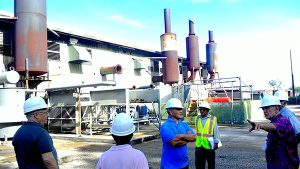Carter again inspects CUC power plants’ projects

As what has become standard practice for U.S. District Court for the NMI designated Judge David O. Carter, he again inspected yesterday the projects being handled by construction company Gilbane Federal at the Commonwealth Utilities Corp. power plants in Puerto Rico and Lower Base.
At Power Plant 4 in Puerto Rico, Carter first checked the installation of four oil/water separators, which is 70% complete; completion is expected this April.
Gilbane Federal principal Daryl Greenway explained how the OWS work. The judge asked Greenway and other CUC officials some questions and took photographs at the project. Gilbane Federal is a California-based company that Carter selected as the Engineering and Environmental Management Company that has been tasked to oversee some stalled CUC projects.
In his recent status report to the federal court, Bradley R. O’Brien, senior attorney of the U.S. Department of Justice Environmental Enforcement Section, said that Gilbane Federal is also preparing the engineering design for the Power Plants 1 and 2 OWS system for treated water discharge features. O’Brien said design is expected to be completed approximately in December 2020.
CUC’s newly hired technical manager for oil, Ray S. Masga, said in an interview that there’s been a lot of progress going on in the construction of the OWS unit.
The TMO said the oil/water separators would collect all high-risk contact water from different areas of the Power Plant 4. “High-risk contact water basically means that this water that’s coming through are in contact with oil. So that’s pretty much water that needs to be treated,” he said.
Masga said the water would be actually treated through the separator systems.
“Right now, they are still doing the setup for the piping,” Masga said. It’s the piping that would need to channel all the high-risk contact water into one collection area before it gets into the treatment system.
Masga said the OWS units could process up to 400 gallons per minute, with each unit capable of processing 100 gallons per minute.
“That’s how much water [will be treated] if you have significant rain, everything that’s [going to] go through that containment system,” he said.
Rather than spilling the water right on the ground, they have to collect those and treat them before they get discharged, Masga said.
After inspecting the OWS, Carter checked the two new horizontal fuel storage tanks that have been installed at the same Power Plant 4. Each tank has the capacity to hold 20,000 gallons.
Greenway and other Gilbane Federal staff explained to Carter how the tanks work.
O’Brien stated in his report that the two tanks are in daily use and commissioning will occur in the near future.
O’Brien said the tanks will replace CUC’s two highly corroded tanks that have already been removed.
A third 20,000-gallon horizontal fuel storage tank is expected to arrive today, Wednesday, from California. Installation is expected to be completed this April.
“Just a beautiful tank sitting here, a beautiful 20,000-gallon tank sitting right here. Isn’t that amazing?” Carter said.
Carter also checked other areas of Power Plant 4 and consulted Greenway and CUC officials on future projects needed at the power plant.
O’Brien said in his report that engineering design work continues for drainage control projects, including storm water run-on control, to minimize the volume of water entering the Power Plant 4 property from an adjacent hillside.
O’Brien said both the U.S. Environmental Protection Agency and CUC are identifying future priority projects and will present recommendations to Carter.
After Power Plant 4, Carter went on to inspect power plants 1 and 2.
CUC managing director Gary P. Camacho, who was among CUC officials who joined the inspection, disclosed in an interview that Carter inspected the power plants’ new incinerators and the oil storage facility and oil containment facilities for petroleum.
Camacho said Carter wanted to see the progress that has been made since the last status conference. “He comes to visit and see that there are projects going forward,” Camacho said.
Carter’s inspections were part of a status conference that he has been conducting since Monday.
Projects discussed or to be tackled at the conference include installing a dual-unit incinerator system at CUC’s power plants 1 and 2 , improving facility drainage systems at power plants 1 and 2, and at Power Plant 4 in Puerto Rico.
Other projects discussed include installation of the new horizontal storage tanks at Power Plant 4 and completing the Rota Power Plant fuel filtration or “eliminator” system.




